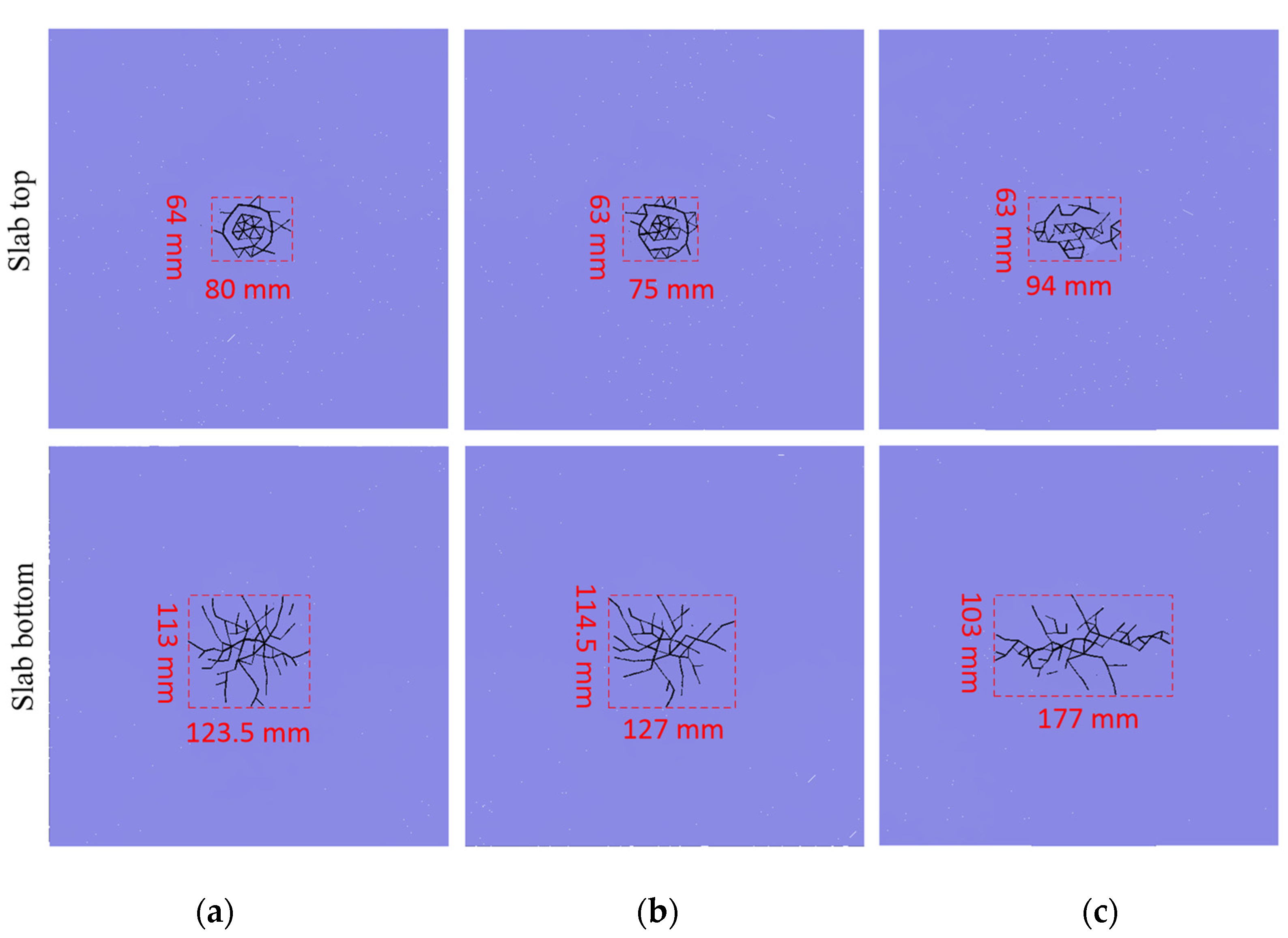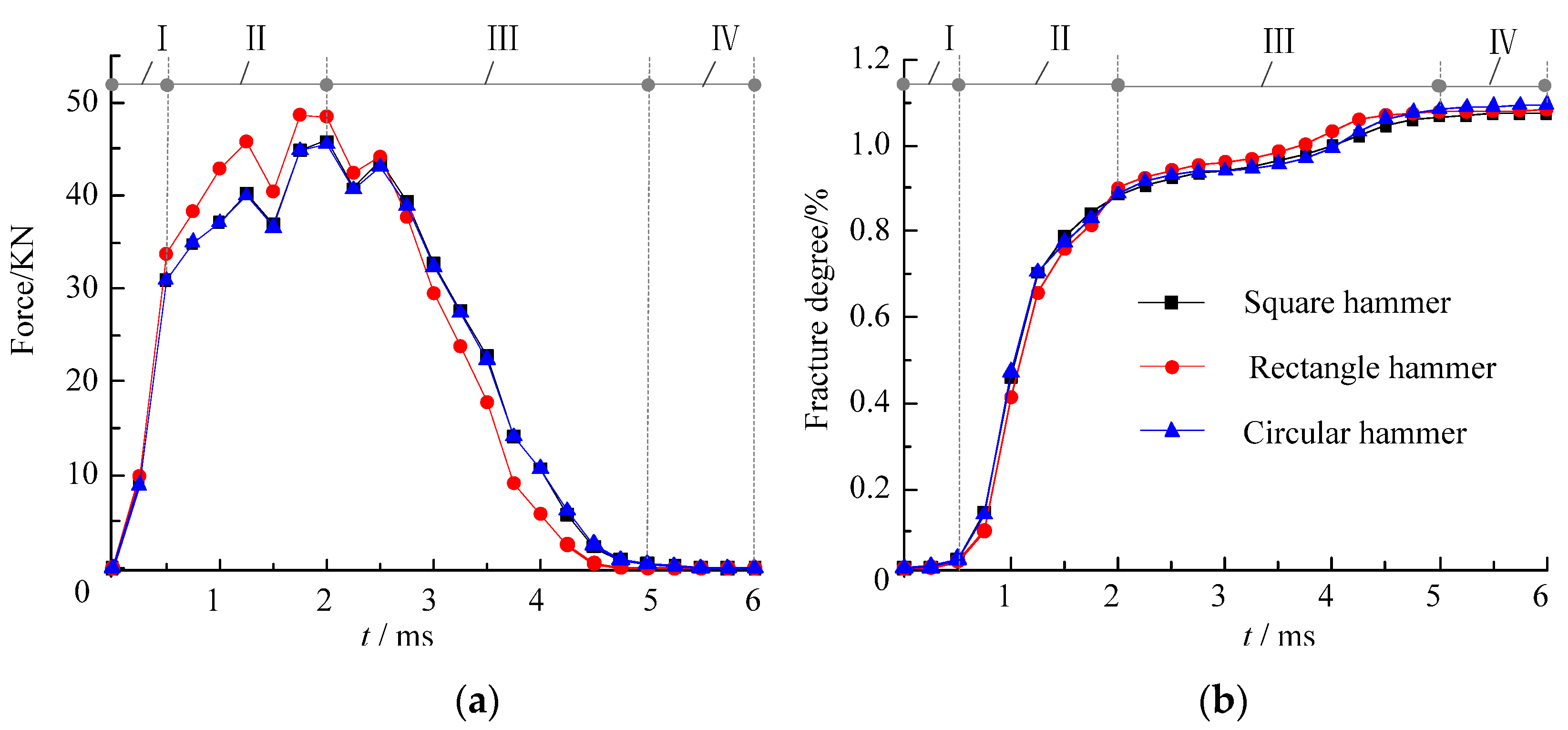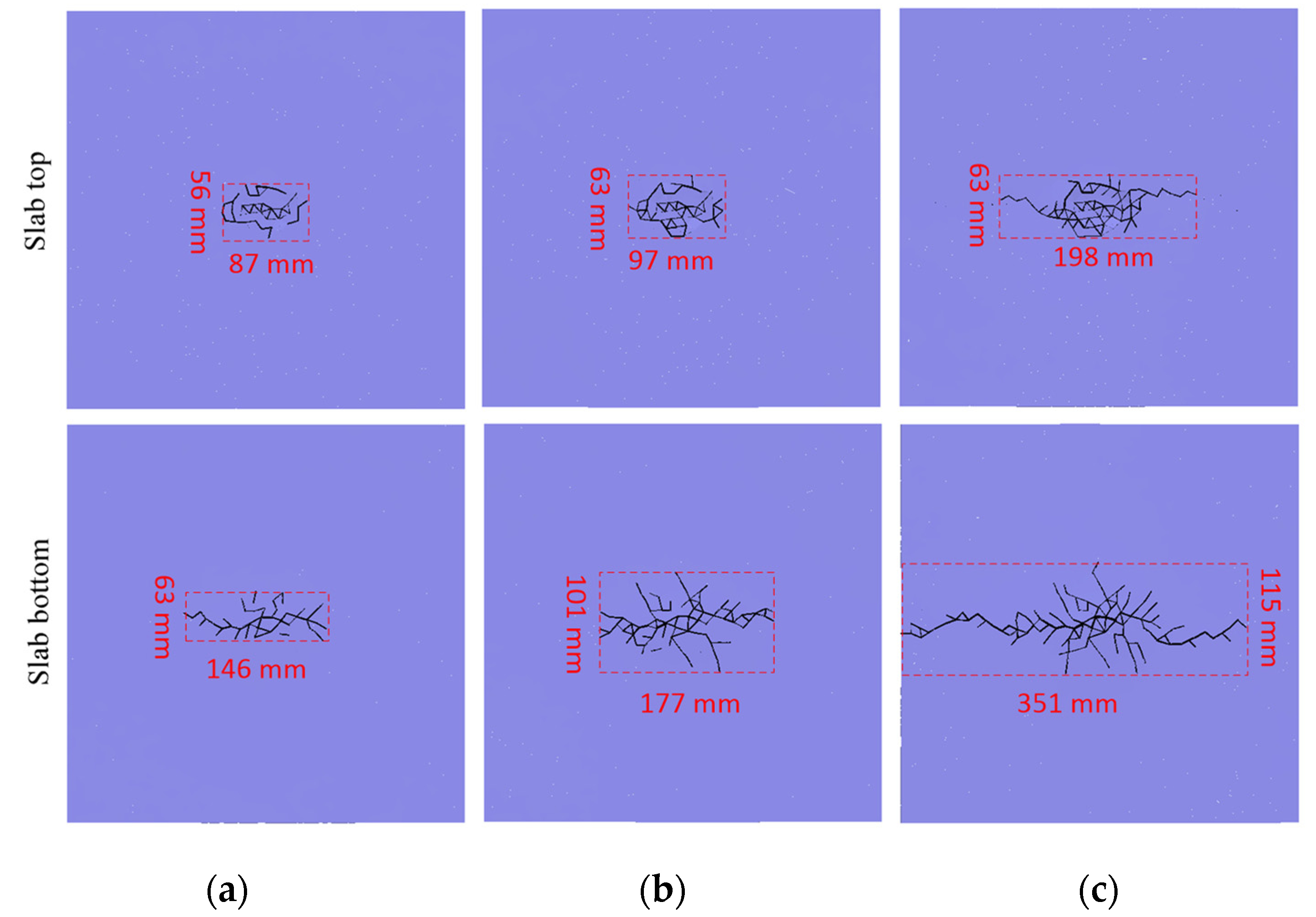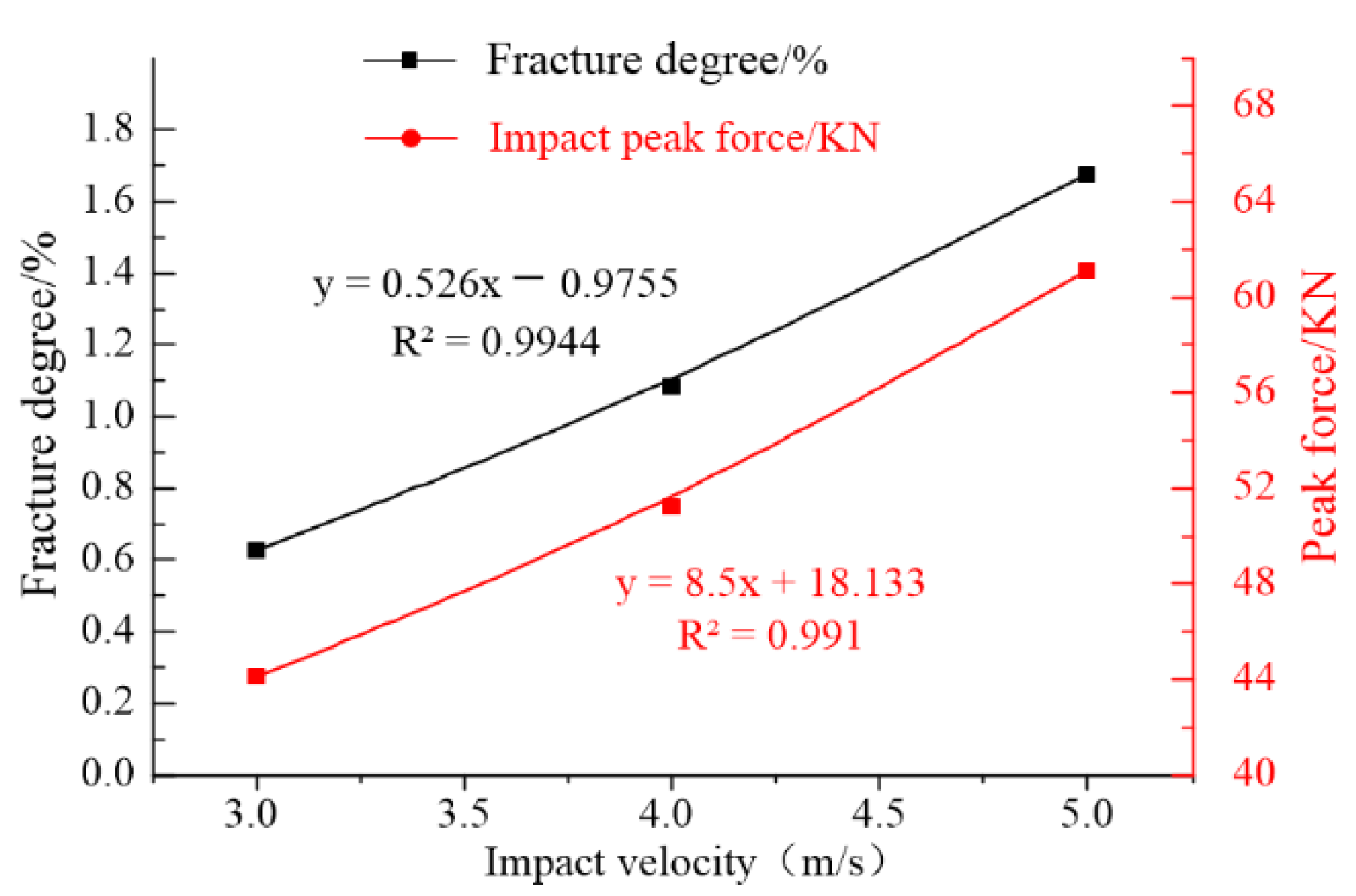Investigation of the Fracture Characteristics of a Cement Mortar Slab under Impact Loading Based on the CDEM
Abstract
1. Introduction
2. Continuum–Discontinuum Element Method
3. Numerical Model, Mechanical Parameters, and Simulation Scheme
3.1. Numerical Models of Impact Test
3.2. Mechanical Parameters in Simulation
3.3. Simulation and Analysis Schemes
4. Simulation Results and Analysis
4.1. Effect of Hammer Shapes on Cracking Mechanism
4.1.1. Analysis of Impact Fracture Forms on the Cement Mortar Slab
4.1.2. Impact-Stress Analysis of Hammerheads
4.1.3. Impact Reaction and Rupture Degree Analysis
4.2. Effect of Impact Speed on Cracking Mechanism
4.2.1. Analysis of Impact Fracture Forms on the Cement Mortar Slab
4.2.2. Impact Reaction and Rupture Degree Analysis of Cement Mortar Slab
5. Discussion
6. Conclusions
- The shapes of the impact hammerheads had a significant effect on the crack model of the mortar slab. The crack model of the slab’s top showed a circular, square, or rectangular distribution that corresponded to the impact-head shapes. The mortar slab’s bottom produced symmetrical dispersion cracks under the circular and square hammerheads. However, the impact cracks mainly propagated along the longitudinal direction of the rectangular hammer. Under the differently shaped hammerheads, the effective fracture area of the mortar slab’s top was significantly smaller than that of the slab’s bottom; under the circular and square hammers, the sizes and shapes of the effective fracture zones on slab’s top and bottom were close, while the effective fracture zone of the rectangular hammer’s impact was significantly greater than those under the circular- and square-section hammers.
- Under the same initial velocity and different hammerhead shapes, the impact reactions and rupture degrees of the mortar slab showed an opposite trend. The ability to transmit the impact force to the slab’s bottom decreased as the rupture degree increased, so the impact reaction generated by the supporting plate was also smaller. The peak value (45.5 KN) of the impact force under the circular hammer was slightly smaller than the peak value (45.9 KN) of the impact force under the square hammer, which in turn was significantly smaller than the peak value (48.7 KN) of the impact force under the rectangular hammer. However, the final value (1.096%) of the rupture degree under the circular hammer was significantly larger than that under the rectangular hammer (1.083%), which in turn was larger than that under the square hammer (1.075%). The impact velocity was also an important factor that affected the mortar slab cracking. With an increase in the initial impact velocity, the effective fracture area of the mortar slab increased significantly. The maximum impact force showed a linear growth trend and a linear fitting degree R2 of 0.991; the final rupture degree also increased linearly and showed a linear fitting degree R2 of 0.9944.
- When the impact velocities and impact areas of the hammerheads were constant, the stress concentration (maximum stress 147.3 MPa) caused by the rectangular hammer’s impact was greater than that (145.5 MPa) of the square hammer’s impact, which in turn was significantly greater than that (87.5 MPa) of the circular hammer’s impact. Therefore, the rupture area, rupture degree, crack form, and impact force of the mortar slab under the rectangular hammer’s impact were significantly different from those of the circular and square hammers. Moreover, corresponding to the section characteristics of the rectangular hammer, the mortar slab was prone to directional rupture; therefore, the rectangular hammer should be more suitable for reconstruction projects involving mortar slab structures.
7. Outlook
Author Contributions
Funding
Institutional Review Board Statement
Informed Consent Statement
Data Availability Statement
Conflicts of Interest
References
- Ma, J.; Sun, S.Z.; Rui, H.T. Review on China’s road construction machinery research progress: 2018. China J. Highw. Transp. 2018, 31, 136–139. [Google Scholar]
- Li, W.; Zhang, Q.; Zhi, Z.; Feng, C.; Cai, Y.; Yue, J. Investigation on the fracture mechanism of homogenized micro-crack crushing technology for portland cement conc rete pavement rehabilitation. AIP Adv. 2019, 9, 075113. [Google Scholar] [CrossRef]
- Fu, J.; Yang, J.; Yin, L.; Liu, W.; Wang, J.; Chen, Z. Dynamic Properties of Zirconia Ceramic Bullets under High-Speed Impact. J. Chin. Ceram. Soc. 2016, 44, 346–352. [Google Scholar]
- Zu, Z.; Yuan, T.; Tang, S.; Dai, X. Repeated Low Velocity Impacts on Honeycomb Sandwich Panels and Residual Strength after Impacts. Sci. Technol. Eng. 2019, 19, 101–109. [Google Scholar]
- Chen, Y.; May, I.M. Reinforced concrete members under drop-weight impacts. Proc. Inst. Civ. Eng.-Struct. Build. 2009, 162, 45–56. [Google Scholar] [CrossRef]
- Dey, V.; Bonakdar, A.; Mobasher, B. Low-velocity flexural impact response of fiber-reinforced aerated concrete. Cem. Concr. Compos. 2014, 49, 100–110. [Google Scholar] [CrossRef]
- Yoo, D.Y.; Yoon, Y.S. Influence of steel fibers and fiber-reinforced polymers on the impact resistance of one-way concrete slabs. J. Compos. Mater. 2014, 48, 695–706. [Google Scholar] [CrossRef]
- Zhang, W.M.; Chen, S.H.; Zhang, N.; Zhou, Y. Low-velocity flexural impact response of steel fiber reinforced concrete subjected to freeze–thaw cycles in NaCl solution. Constr. Build. Mater. 2015, 101, 522–526. [Google Scholar] [CrossRef]
- Zhang, W.M.; Chen, S.H.; Liu, Y.Z. Effect of weight and drop height of hammer on the flexural impact performance of fiber-reinforced concrete. Constr. Build. Mater. 2017, 140, 31–35. [Google Scholar] [CrossRef]
- Anil, O.; Kantar, E.; Yilmaz, M.C. Low velocity impact behavior of RC slabs with different support types. Constr. Build. Mater. 2015, 93, 1078–1088. [Google Scholar] [CrossRef]
- Radnić, J.; Matešan, D.; Grgić, N.; Baloević, G. Impact testing of RC slabs strengthened with CFRP strips. Compos. Struct. 2015, 121, 90–103. [Google Scholar] [CrossRef]
- Sakthivel, P.B.; Ravichandran, A.; Alagamurthi, N. Impact strength of hybrid steel mesh-and-fiber reinforced cementitious composites. KSCE J. Civ. Eng. 2015, 19, 1385–1395. [Google Scholar] [CrossRef]
- Yahaghi, J.; Muda, Z.C.; Beddu, S.B. Impact resistance of oil palm shells concrete reinforced with polypropylene fibre. Constr. Build. Mater. 2016, 123, 394–403. [Google Scholar] [CrossRef]
- Elavarasi, D.; Mohan, K.S.R. On low-velocity impact response of SIFCON slabs under drop hammer impact loading. Constr. Build. Mater. 2018, 160, 127–135. [Google Scholar] [CrossRef]
- Fu, Y.; Dong, X. An experimental study on impact response and failure behavior of reinforced concrete beam. Sci. Sin. Technol. 2016, 46, 400–406. [Google Scholar]
- Mei, F.; Dong, X.; Yu, X. On failure behavior of concrete and RC beam to different velocity impact. J. Ningbo Univ. Nat. Sci. Eng. Ed. 2017, 30, 83–88. [Google Scholar]
- Gu, S.; Peng, F.; Yu, Z.; Li, J. An experimental study on the damage effects of the concrete slabs under low-velocity impact. J. Vib. Shock. 2019, 38, 107–114. [Google Scholar]
- Nia, A.A.; Hedayatian, M.; Nili, M.; Sabet, V.A. An experimental and numerical study on how steel and polypropylene fibers affect the impact resistance in fiber-reinforced concrete. Int. J. Impact Eng. 2012, 46, 62–73. [Google Scholar]
- Gopinath, S.; Ayashwarya, R.; Kumar, V.R.; Prem, P.R. Low velocity impact behaviour of ultra high strength concrete panels. Sadhana-Acad. Proc. Eng. Sci. 2014, 39, 1497–1507. [Google Scholar] [CrossRef]
- Othman, H.; Marzouk, H. An experimental investigation on the effect of steel reinforcement on impact response of reinforced concrete plates. Int. J. Impact Eng. 2016, 88, 12–21. [Google Scholar] [CrossRef]
- Othman, H.; Marzouk, H. Impact response of ultra-high-performance reinforced concrete plates. Aci. Struct. J. 2016, 113, 1325–1334. [Google Scholar] [CrossRef]
- Othman, H.; Marzouk, H. Finite-element analysis of reinforced concrete plates subjected to repeated impact loads. J. Struct. Eng. 2017, 143, 04017120. [Google Scholar] [CrossRef]
- Xiao, Y.; Li, B.; Fujikake, K. Experimental study of reinforced concrete slabs under different loading rates. Aci Struct. J. 2016, 113, 157–168. [Google Scholar] [CrossRef]
- Xiao, Y.; Li, B.; Fujikake, K. Predicting response of reinforced concrete slabs under low-velocity impact. Mag. Concr. Res. 2017, 69, 996–1010. [Google Scholar] [CrossRef]
- Zhao, W.Y.; Guo, Q.Q.; Dou, X.Q.; Zhou, Y.; Ye, Y. Impact response of steel-concrete composite panels: Experiments and FE analyses. Steel Compos. Struct. 2018, 26, 255–263. [Google Scholar]
- Zhang, Q.; Zhi, Z.; Feng, C.; Cai, Y.; Pang, G.; Yue, J. Investigation of concrete pavement cracking under multi-head impact loading via the continuum-discontinuum element method. Int. J. Impact Eng. 2020, 135, 103410. [Google Scholar] [CrossRef]
- ACI Committee 544. ACI 544.2R-89: Measurement of Properties of Fiber Reinforced Concrete; American Concrete Institute: Indianapolis, IN, USA, 1999; pp. 6–7. [Google Scholar]










| Density/kg × m−3 | Elastic Modulus/GPa | Poisson’s Ratio | |
|---|---|---|---|
| Hammer | 7850 | 200 | 0.25 |
| Cement mortar | 2400 | 28 | 0.2 |
| Normal Stiffness/Pa × m−1 | Tangential Stiffness/Pa × m−1 | Cohesion/MPa | Internal Friction Angle/° | Tensile Strength/MPa | |
|---|---|---|---|---|---|
| Concrete interface | 2 × 1011 | 1 × 1011 | 6 | 54.9 | 5 |
| Impact interface | 2 × 1011 | 0 | 0 | 54.9 | 0 |
| Support interface | 2 × 1010 | 0 | 0 | 54.9 | 0 |
Disclaimer/Publisher’s Note: The statements, opinions and data contained in all publications are solely those of the individual author(s) and contributor(s) and not of MDPI and/or the editor(s). MDPI and/or the editor(s) disclaim responsibility for any injury to people or property resulting from any ideas, methods, instructions or products referred to in the content. |
© 2022 by the authors. Licensee MDPI, Basel, Switzerland. This article is an open access article distributed under the terms and conditions of the Creative Commons Attribution (CC BY) license (https://creativecommons.org/licenses/by/4.0/).
Share and Cite
Zhang, Q.; Wang, D.; Yue, J.; Feng, C.; Yuan, R. Investigation of the Fracture Characteristics of a Cement Mortar Slab under Impact Loading Based on the CDEM. Materials 2023, 16, 207. https://doi.org/10.3390/ma16010207
Zhang Q, Wang D, Yue J, Feng C, Yuan R. Investigation of the Fracture Characteristics of a Cement Mortar Slab under Impact Loading Based on the CDEM. Materials. 2023; 16(1):207. https://doi.org/10.3390/ma16010207
Chicago/Turabian StyleZhang, Qunlei, Decai Wang, Jinchao Yue, Chun Feng, and Ruifu Yuan. 2023. "Investigation of the Fracture Characteristics of a Cement Mortar Slab under Impact Loading Based on the CDEM" Materials 16, no. 1: 207. https://doi.org/10.3390/ma16010207
APA StyleZhang, Q., Wang, D., Yue, J., Feng, C., & Yuan, R. (2023). Investigation of the Fracture Characteristics of a Cement Mortar Slab under Impact Loading Based on the CDEM. Materials, 16(1), 207. https://doi.org/10.3390/ma16010207










